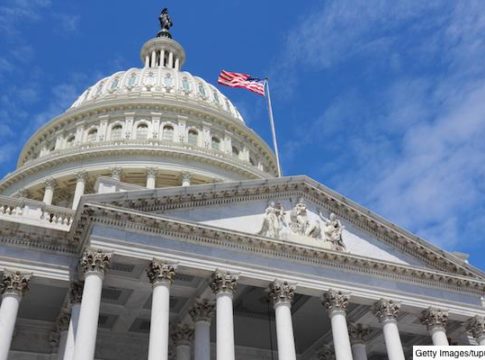This is the second in a series of three blog posts about how state and local education policy would be affected by the repeal of ESSA regulations that were written during the Obama administration. Monday, Brandon L. Wright laid out the big picture by describing what Congress is expected to do and what should happen next. Today, Anne Hyslop looks at some of the unintended consequences of repealing the ESSA regulations, such as eliminating key flexibilities and leaving a murkier understanding of what the law requires. Wednesday, Christy Wolfe looks at the importance of regulatory clarity when it comes to school choice.
Congress was in recess last week, but now that it has returned, it is likely that a resolution to rescind the final Every Student Succeeds Act (ESSA) regulations for accountability, data, and consolidated state plans, using the Congressional Review Act (CRA), will be introduced—a resolution that’s already cleared the House and that is supported by the Trump Administration. But unlike the usual process an agency follows to repeal regulations, after a CRA resolution the Department will be prohibited from issuing (without congressional approval) any set of regulations that are substantially the same.
 Brandon Wright and others have already weighed in on some of the implications of this move, and how it could hamper efforts to implement the new law and states’ ability to meaningfully use ESSA to innovate and adopt novel approaches to school accountability and improvement. Rather than provide states and districts with more control over their accountability and improvement systems, as Congress intends, the side effects of the CRA can actually impinge on these efforts.
Brandon Wright and others have already weighed in on some of the implications of this move, and how it could hamper efforts to implement the new law and states’ ability to meaningfully use ESSA to innovate and adopt novel approaches to school accountability and improvement. Rather than provide states and districts with more control over their accountability and improvement systems, as Congress intends, the side effects of the CRA can actually impinge on these efforts.
Certain aspects of the final regulations—the debate over the School Quality or Student Success indicator, or whether states must produce a summative rating—are well understood and have been thoroughly debated over the past year. What is not well understood, it appears, is the non-headline-generating, but just as important, role the regulations played in two key areas.
Adding flexibility through regulations
First, the regulations codify additional flexibilities that ESSA alone does not provide to states. In these areas, the regulations clearly signal that certain approaches are okay, giving state education agencies (that are often compliance-oriented) the green light to adopt them and a clear hook to use with stakeholders and state leaders, who may be skeptical of whether a strategy is permitted. For example, the final regulations give states more flexibility around using achievement indices, rather than a simple “percent proficient” metric, and permit states to use multiple years of data and average them over time for accountability decisions. These flexibilities cannot be found in the statutory text, and in the absence of regulations, states may default back to the status quo and take the less risky path by hewing closely to the statute, rather than pushing for more creative solutions that work better in their local contexts. Furthermore, in some cases the regulations were needed to provide for a smooth transition for states and a logical implementation path. Delaying the timeline for identification, for instance, recognized that states were not prepared to meet the statutory deadline of 2017–18 for implementing their new identification and school improvement systems, just as the regulations clarified when each subsequent piece (including new data reporting) of the law kick in. These examples, and the list below, provide just a sample of how the regulations serve to provide states and districts with more options for ESSA implementation—options that are less clear after a CRA repeal.
20 flexibilities added through regulation where ESSA is silent
1. States may stagger their implementation timelines so that they use indicators based on the 2017–18 school year to identify their first cohort of low-performing schools in 2018–19. States may also have a planning year so that interventions in these schools must fully kick in by the 2019–20 school year.
2. States can use the Academic Achievement indicator to give schools partial or extra credit, via an achievement index, for students that are either approaching or exceeding proficiency.
3. States may develop varying methodologies to differentiate and identify low-performing schools in order to include special kinds of schools in their statewide system (such as newly opened schools, very small schools, schools with non-traditional grade configurations, schools without tested grades, and schools designed to serve unique populations like newcomer schools).
4. States need not identify schools for “additional targeted support” annually because these schools are identified for having a subgroup performing similarly to students in the bottom 5 percent of Title I schools; rather, states can identify these schools every three years, each time they identify their lowest-performing 5 percent of schools.
5. States may continue to average data for accountability purposes across school years and across grades in a school.
6. States can choose to use a lower n-size for reporting data on state and district report cards than for accountability purposes, including identifying schools for support and improvement.
7. States may use graduation rate data for accountability purposes (especially identification of low-graduation-rate high schools) that lag a year behind other accountability data to account for summer graduates.
8. States may report certain information required on online school report cards at a later point in time than other metrics, such as per-pupil expenditure data (which lag due to the fiscal calendar). In addition, new measures (like college enrollment data) can be added to report cards at a later point in time and need not be reported the first time states produce their ESSA report cards.
9. States can use a hyperlink to another part of their state website to provide parents and other users with a full description of their school accountability system on district and school report cards, enabling states to reduce the length of their report cards and preventing duplicative information.
10. States must ensure that at least one intervention in identified schools will be evidence-based, but all activities in the school’s improvement plans do not need to be supported by evidence (as defined in ESSA).
11. States may provide school improvement funds under section 1003 funds to any school identified for comprehensive or targeted support and improvement, even if the identified school is not a Title I school.
12. States may create lists of evidence-based interventions to better support school improvement plans developed by districts and schools; use of the list may be optional or required, depending on the state’s policy preference.
13. While comprehensive support plans must be approved by the state, district, and schools, the regulations provide states the final authority to ensure these plans pass muster, are completed, and can be implemented, particularly if districts or schools disagree on elements of the plan and are at an impasse.
14. States can tailor their English language proficiency (ELP) goals for different groups of English learners, rather than setting a single timeline for achieving ELP that all students must meet; the timeline applied to a particular group of English learners can vary depending on the characteristics of those students.
15. States can include the test scores of former students with disabilities in subgroup data for up to two years for accountability purposes.
16. States can include both former English learners and students with disabilities in the respective subgroups for any indicator that is based on state test scores, rather than only the Academic Achievement indicator.
17. States may include both former English learners and students with disabilities in calculating graduation rates if they were part of the subgroup at any point during high school, even if the student exited during high school.
18. States can take advantage of both statutory exemptions for including recently arrived English learners in accountability systems, using student-level characteristics to determine which exception is appropriate for which students.
19. States may use a composite score within their accountability systems in order to include English learners with disabilities in cases where students cannot be tested on all four ELP domains.
20. States may count recently arrived English learners in participation rate calculations if that student is included in the accountability system by using an exception where they take the state’s ELP test instead of its English language arts assessment.
Adding clarity through regulations
In addition to providing states more flexibility than the statute alone, the regulations both promote consistency and clarity across states and provide public transparency in the development and implementation of ESSA locally. Few would argue that there is no need for common definitions regarding how to report high school graduation rates—a consensus that’s been in place since the 2008 adjusted cohort graduation rate rules were first issued. ESSA codified much of the 2008 rules, but also expanded on them by providing a way for students with the most significant cognitive disabilities who graduate with alternate diplomas to be counted in the four-year rate, even if it takes longer for them to complete high school, requiring more disaggregated graduation rate reporting. Thus, the final ESSA regulations update the existing rules to ensure that these newly added ESSA provisions would be implemented in a common way. If the CRA resolution succeeds, the new graducation rate reporting requirements would be eliminated, eroding the reliability and uniformity of these data and creating a disconnect between the statute and the regulations (the outdated 2008 rules would remain in place).
The final ESSA regulations, not the statute, also ensured that parents would be fully informed about the performance of their school—requiring district report cards to include whether schools were identified for support and improvement, setting the expectation that parents are directly notified if their child attends an identified school, and ensuring that there is meaningful engagement from parents and the community in developing not just the state ESSA plan, but also school improvement plans. With school choice likely to be a big focus of the new Administration’s education agenda, these efforts will be undermined if parents lack the basic information they need to make an informed choice about other options, which the regulations provide.
While it can be easy to argue that uniform rules are always burdensome for states, these, and the examples below, demonstrate areas where the ambiguity in the statute present a compelling case for the Department to provide more specificity. The regulations enhance transparency for parents and families, safeguard vulnerable populations of students, and ensure that the accountability and reporting systems required by ESSA promote clarity, rather than chaos and confusion.
20 rules providing consistency, transparency, or clarity that would be lost
1. States must report the adjusted cohort graduation rate in a consistent manner, so that (1) all states count students with the most significant cognitive disabilities earning alternate diplomas in the four-year graduation rate in the same way (even if they graduate in more than four years), and (2) reporting graduation rates for new student populations (homeless students, students in foster care, etc.) is uniform.
2. States must develop a uniform procedure for reporting per-pupil expenditure data, ensuring uniformity in how this new information is conveyed across all districts in the state. Similarly, each must develop a common way for reporting of new educator data, defining terms like “inexperienced” and “out of field” teachers.
3. District and school report cards must include a school’s accountability status (i.e., basic information about whether it’s been identified for support and improvement), in addition to the description of the accountability system required by the law.
4. Parents must be informed in some timely manner by their district if their child attends a school that has been identified for comprehensive or targeted support, enabling parents to become involved in school improvement efforts and to exercise school choice, if applicable.
5. States must identify schools for comprehensive or targeted support by the beginning of the school year in order to ensure prompt notification to parents and timely development of school improvement plans.
6. Districts must include basic school information on their report cards for parents and the public, such as the school’s name, address, phone number, email, student membership count, and Title I status.
7. Report cards must be provided directly to parents by school districts, and all report cards must be published by December 31 each year to ensure that the information collected is provided in time to be useful for educators, administrators, elected officials, parents and families, and community stakeholders.
8. Each state’s accountability system must be statewide—in other words, a single system used throughout the state, with a uniform methodology for differentiating and identifying schools for improvement.
9. States must include each major racial/ethnic subgroup in school accountability systems and cannot use a combined “super subgroup” of minority students. Furthermore, the regulations define new subgroups (like military-connected students and students in foster care) for whom ESSA adds new reporting requirements.
10. Any state choosing to include former English learners and/or students with disabilities in its accountability system cannot cherry pick which students to include; all former students in those subgroups must be captured.
11. States must use the same n-size for all accountability purposes, ensuring that a different n-size cannot be selected for including English learners in the English language proficiency indicator than for the Academic Achievement indicator or Graduation Rate indicator.
12. To identify schools for targeted support with a consistently underperforming subgroup, a state’s definition must consider all indicators, but the subgroup need not be underperforming on all indicators in order to be named a targeted support school.
13. States must identify all schools with a subgroup performing similarly to the lowest-performing 5 percent of the Title I schools for “additional targeted support” in 2018–19, but states do not have to begin annual identification of schools with consistently underperforming subgroups of students for targeted support until 2019–20—clarifying the two distinct kinds of targeted support schools, with different identification and exit criteria.
14. States must make their exit criteria for identified schools transparent and publicly available, just as districts must ensure that school improvement plans are publicly posted to build awareness and understanding among the local community.
15. States that permit students in comprehensive support schools to transfer to another school must ensure that the receiving school is higher-performing—that is, that it is not (1) among the lowest-performing 5 percent of schools in the state or (1) a high school with graduation rates below 67 percent.
16. States must identify low-graduation-rate high schools using the four-year adjusted cohort rate; the statute is silent on the graduation rate measure that should be used here even though the four-year rate must be used for goal-setting under the law.
17. States that develop accountability indicators that include multiple measures (e.g., a college and career readiness indicator that includes Advanced Placement or International Baccalaureate participation and performance, SAT or ACT scores, dual enrollment, or attainment of industry credentials) must report on each individual measure within the indicator, in addition to including school information on the indicator as a whole.
18. In addition to identifying the local education agency for each charter school on its district report cards, report cards must also indicate the relevant charter authorizer for the school to provide greater transparency in states with multiple authorizers.
19. States must communicate with parents and other stakeholders in a manner that is accessible, including by providing written information in languages that parents can understand and, where practicable, by providing information in alternate formats for parents with disabilities.
20. States must develop their state ESSA plans by conducting meaningful stakeholder engagement with a broad array of groups (beyond those listed in the statute) and take into account feedback at all phases of the process—planning, drafting, implementation, and revision (which the rules clarify must occur at least once every four years). Furthermore, many of these principles also apply to the collaborative process districts and schools must use to develop school improvement plans in partnership with their local communities.
What’s at stake
The CRA isn’t just some bureaucratic exercise. It has real consequences, and they are far-reaching—implicating not only the process for states to submit their ESSA plans in the short term but also their long-term ability to use ESSA as a powerful lever for change by eliminating key flexibilities and leaving a murkier understanding of what the law requires among state leaders and critical stakeholders.
If congressional Republicans and members of the Administration feel that some policies in the regulations go too far in limiting state authority, that’s fair, and they have tools at their disposal to change those policies, such as issuing non-regulatory guidance or re-regulating under the standard notice-and-comment process. But knocking out the final rule in full and handcuffing the Department of Education from regulating in the future is ill-advised if the goal is to let states lead. On net, the regulations do more to empower states, local communities, and parents and clarify what’s possible under the law than they do to limit them. Case in point: The wide range of approaches proposed in the many draft ESSA plans currently circulating. States can only take advantage of ESSA’s opportunities if they know how to—and rescinding the regulations takes away one of the most powerful ways they can learn.
— Anne Hyslop
Anne Hyslop served as a Senior Policy Advisor at the U.S. Department of Education in the Obama Administration and is now a Senior Associate for Policy and Advocacy at Chiefs for Change.
Anne Hyslop provided this commentary as an independent author. This post does not represent the official policy positions of Chiefs for Change or its members.
This post originally appeared in Flypaper.





